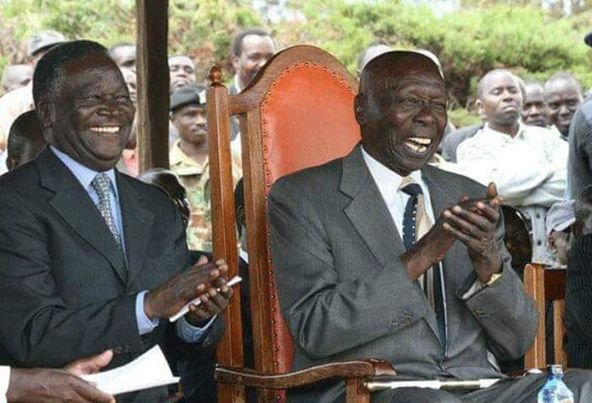Who was Biwott? Nobody seems to know much about his private life. But everyone agrees that he was a very scared man. Scared, even of his shadow. And was always on the lookout over his shoulder for death.
Money, again! Money can bring loneliness???
The story of Biwott is intriguing. I bet you learn something here that you didn’t know…
A photo of Former Cabinet Minister Nicholas Biwott’s widows Margaret Kamar, Hannie Biwott and Kalista Lessie as they were introduced to the hundreds who turned up to view his body at Biwott Day Secondary School in Keiyo South ahead of his burial
Nicholas Biwott had seven children – six daughters and a son
Biwott was MP for Keiyo South for 28 years and Cabinet minister for 25.
Born in 1940 to Cheserem Soti and Maria Soti of Chebior village in Keiyo, The late Nicholas Biwott, one-time powerful sidekick of retired President Daniel arap Moi, was so obsessively secretive that even Mzee Moi once wondered aloud whether anyone had ever been invited to Biwott’s home.
No one in government seemed to know where Biwott lived in Nairobi, or his several homes in Elgeyo Marakwet, Uasin Gishu County. Even the security detail had no clue where he would spend the night. His offices operated without a formal itinerary.
The diminutive politician once worked as a personal assistant to Jewish Mossad spy in Kenya Bruce Mckenzie, the only white Cabinet minister in Jomo Kenyatta’s government until 1969, when he resigned.
For more than 50 years, Biwott led a lonely life, dodging friends and relatives, glancing over his shoulders for real or imaginary enemies, and avoiding food served in public.
The former Minister for Energy and MP for Keiyo South also denied himself the creature comforts worthy of his billions by hiking lifts in jalopies you wouldn’t even wish on your enemies. He never owned a cellphone.
Regarded as an intelligent man, Mr Biwott started his career as a junior information officer in Eldoret under Mr Kendagor Bett, the Alliance High School alumnus whose newsletter Kalenjin would help rally the community behind the Kenya African Democratic Union (Kadu), whose Rift Valley kingpin was Daniel arap Moi. It was during this period that Mr Moi met Mr Biwott.
The rise of Nicholas Biwott and how he ended up in Australia on a government scholarship is credited to the intervention of Mr Kenneth Matiba, the Makerere University graduate who was in charge of scholarships at the Ministry of Education.
Mr Biwott studied for a Bachelors degree at the University of Melbourne between 1962 and 1964 and during his second sojourn to Australia in 1966, he returned home with a Masters degree in economics and a wife, Hannie — a Dutch of Jewish origin.
It was after his return that Mr Biwott immersed himself into the Jewish circles in Nairobi, earning the confidence of Mr Mackenzie, the politician whose commercial interests in Kenya included shareholding in pivotal companies such as Cooper Motors Corporation (CMC), Wilken Air, and Wilken Telecommunications, which had won the tender to build Kenya’s first satellite earth station in Kenya.
Biwott invested in construction, property development, and the oil importation business and was a shareholder in HZ Company, which monopolised road contracts in Kenya. His other company, Lima Ltd, would later on try to seize part of Karura Forest, triggering a bitter war with environmentalist Wangari Maathai. Lima had been given 16 acres of the forest and was selling them at Sh60 million each.
His other companies included Air Kenya, Yaya Centre, and a huge stake at the oil company Kenol-Kobil where he has been divesting.
Though a slave to his wealth and murky past, the man who controlled the recruitment and rotation of presidential guards, could not run away from the vagaries of old age and cancer. Biwott, who died at 77, had been seeking routine treatment in Singapore rather than Europe or America.
Compiled from different sources.
